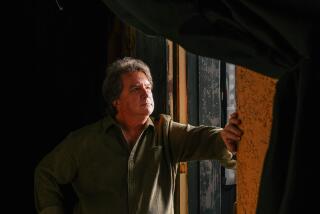He Learned About Dangers of Steroids, Now He’s Telling Others
- Share via
His story, at least the early chapters, could be that of any high school athlete determined to be the best. He was the workout hero, the kind of guy who’d practice with the team all afternoon, then put himself through an extra workout at night.
He didn’t drink, didn’t use drugs, didn’t do anything that might hurt his football career or his straight-A average. His coaches at Ocean View High School called him a role model, and his teammates voted him most inspirational. But the voice inside never thought much of such praise.
The voice inside told him he was nothing.
And more often than not, David Sachs believed.
He was a 5-foot-7, 180-pound defensive end in his senior season, 1984. He hated being smaller than his opponents but made up for it with intensity. Once, realizing his teammates didn’t share his burning desire to win, he walked to the sideline during a game and wept.
He went to UC Santa Cruz, where, without a football team and the pressures of home, he made the weight room his fortress. He started taking natural supplements and reading bodybuilding magazines, wanting to do whatever he could to get big. The more weight he gained, the better he felt about himself. After two quarters, he dropped out of school and took a job in a gym.
It was the perfect environment, he thought. Work out, dust the machines once in awhile, get paid for it. But all the extra hours of lifting weren’t enough. Sachs wanted to be bigger. When a man at the gym told him he could help, Sachs listened. A few days and $120 later, Sachs made his first purchase of anabolic steroids.
He and a friend, a former lineman at Ocean View, took turns injecting themselves. Sachs wasn’t sure what he was taking exactly--the label on the bottle was in German--but he started lifting heavier weights and put in hours at all-you-can-eat buffets, hoping to boost the benefits.
He wasn’t careful. His father, a doctor, found the bag of syringes and told Sachs that using the drug could lead to low sperm count and liver and kidney damage. Sachs promised he wouldn’t use the drugs again.
But less than a year later, he was, this time as a student at Springfield (Mass.) College. Sachs was befriended by bodybuilders from a nearby gym and started buying steroids from students in his dorm. This time, the drugs took effect. With some heavy weight work, Sachs beefed up to 225, but he still didn’t feel big enough.
He started stacking, using a combination of steroids during the same cycle. Before workouts, he’d slip a few tablets under his tongue. To cut down expenses, he thought about selling the drugs himself. Instead, he began strip dancing. It paid about $150 a night, and with women screaming for him and throwing him money, it gave him an ego boost he couldn’t get by flexing in the mirror.
Sachs began taking steroids every day, not just in cycles. His eyes and cheeks were always swollen and puffy, but he didn’t care, just as he didn’t care about the change in his personality. Once meek and modest, Sachs had become a vain, arrogant jerk who became enraged at the slightest annoyance.
Around school, people asked him if he was using steroids. He denied it. During an English class, the teacher showed a film about a sprinter who used steroids, then had a massive heart attack after a race. Sachs was scared but laughed and made jokes through the movie. He knew the teacher was watching him for a reaction.
He graduated from Springfield--with a degree in psychology--and moved into his father’s home in Laguna Niguel. He continued using steroids and lived for the Southern California night life. He got into drinking, pot and acid. Anything, he says, to build his image in others’ eyes. He moved in with an Irvine drug dealer and acted as a body guard. The house and everything in it, including drugs and weapons, were at his disposal.
When his sister found a bag of Sachs’ steroids, the family set up a surprise meeting. Sachs’ parents and siblings told him they were there to make him stop using drugs, but Sachs refused to listen. They checked him into a halfway house, but Sachs packed up and left.
He was so furious at his family, and so lost in life, he made plans with a friend to go to Israel, live in a kibbutz . . . and smuggle drugs for a living.
A physical was required before acceptance into the kibbutz, so Sachs went to see a doctor friend of his father’s. The doctor returned with Sachs’ blood test results. His expression was grim. He told Sachs his liver had been damaged and asked if he was using steroids. They spoke for two hours, and Sachs confessed to his drug use. He was terrified yet relieved. He knew he had no choice but to stop.
That was last spring. Sachs hasn’t used steroids since, and he recently celebrated his 90-day anniversary of sobriety from other drugs and alcohol. Now, he says, the focus in his life is to get well and help others get well, too.
As a counselor for drug- and alcohol-addicted youths at a Newport Beach psychiatric hospital, Sachs says he understands the tremendous denial he had as a steroid user. His first patient was a Woodbridge High athlete who used steroids but denied the problem. Sachs says the only reason he didn’t use steroids in high school was that, at the time, he didn’t know they existed. He’s convinced the numbers are much, much higher than anyone--parents, coaches, administrators--want to admit.
He believes steroid use should be treated the same as other drug addictions, even though the medical community still doesn’t formally recognize it as such. What he wants most, though, is to get people to break through the denial, to make them see it’s a much worse problem than society cares to admit.
Saturday, Sachs is helping conduct an all-day seminar on steroids at the Break Away Health Corp. in Costa Mesa. Although 500 flyers were sent to schools and hospitals in the county, response has been nil. Not one coach, trainer, athlete or administrator has shown interest. Sachs says it’s disappointing, but he’s not giving up.
“People are afraid of the problem, they’re acting like it’s not there,” Sachs says. “But I guarantee you, it’s out there, I know. High school kids ask me about steroids, they want to know where to get it.
“Everyone wants to treat it like it’s not happening, but it is.”
Barbie Ludovise’s column appears Wednesday and Sunday. Readers may reach Ludovise by writing her at The Times Orange County Edition, 1375 Sunflower Ave., Costa Mesa. 92626 or calling (714) 966-5847.
More to Read
Get our high school sports newsletter
Prep Rally is devoted to the SoCal high school sports experience, bringing you scores, stories and a behind-the-scenes look at what makes prep sports so popular.
You may occasionally receive promotional content from the Los Angeles Times.






